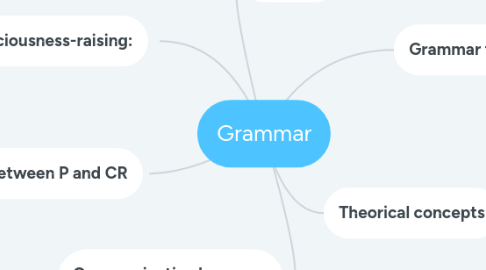
1. Practice:
1.1. Concepts:
1.1.1. Series of exercises whose aim is to transfer what they know from short-term to long-term memory.
1.1.2. Practicing a grammatical structure under controlled conditions does not enable the learner to use the structure freely.
1.1.3. The teaching syllabus has to match the learner’s developmental syllabus
1.1.3.1. The teacher will have to find out what stage of development the learners have reached.
1.1.4. Practice does help where pronunciation is concerned.
1.1.5. Practice is essentially a pedagogical construct.
1.1.6. Practicing a grammatical structure under controlled conditions does not enable the learner to use the structure freely.
1.2. Types of practice
1.2.1. 1. Mechanical practice
1.2.2. 2. Contextualized practice
1.2.3. 3. Communicative practice
1.3. Characteristics
1.3.1. 1. There is attempt to isolate specific grammatical feature for focused attention.
1.3.2. 2. Production of sentences containing the targeted feature.
1.3.3. 3.Opportunities for repetition of the targeted feature.
1.3.4. 4. Expectancy of performing the grammatical feature correctly
1.3.5. 5. The learners receive feedback. This feedback may be immediate or delayed.
1.4. Studies
1.4.1. 1. Those related to the amount of practice achieved by individual learners with general increases in proficiency.
1.4.2. 2. Those that have examined whether practicing a specific linguistic structure results in its acquisition.
1.5. Series of exercises whose aim is to transfer what they know from short-term to long-term memory.
2. Consciousness-raising:
2.1. Information:
2.1.1. It involves to equip the learner with an understanding of a specific grammatical feature to develop declarative rather than procedural knowledge of it.
2.1.2. The main purpose is to develop explicit knowledge of grammar.
2.1.3. It is directed at the formation of explicit knowledge.
2.1.4. The acquisition of implicit knowledge involves three processes:
2.1.4.1. 1. Noticing
2.1.4.2. 2. Comparing
2.1.4.3. 3.Integrating
2.1.5. It contributes to the processes of noticing and comparing and prepares the grounds for the integration of new linguistic material
2.2. Characteristics:
2.2.1. 1. There is an attempt to isolate a specific linguistic feature for focused attention.
2.2.2. 2. The data given will illustrate the targeted feature and it may be supplied with a rule describing or explaining.
2.2.3. 3. Expectation to utilize intellectual effort to understand the targeted feature.
2.2.4. 4. Misunderstanding of the grammatical structure leads to clarification in the form of data and description or explanation.
2.2.5. 5. Learners may be required to articulate the rule describing the grammatical structure.
2.2.6. 2. The learners are provided with data which illustrate the targeted feature and they may also be supplied with an explicit rule describing or explaining the feature.
3. Differences between P and CR
3.1. The main difference is that CR does not involve the learner in repeated production.
3.2. Pis primarily behavioral, CR is essentially concept-forming in orientation.
3.3. P work cannot take place without some degree of CR; CR can occur without P.
3.4. Facilitates the acquisition of the grammatical knowledge needed for communication.
3.5. The construction of explicit representations of grammatical structures is of limited use in itself.
3.6. Explicit knowledge is not much use when it comes to communicating. For this, we need implicit knowledge.
4. Communicative language teaching
4.1. The attention to grammar was eclipsed by an emphasis on experiential learning and purely communicative goals.
4.1.1. Partly true, syllabuses often had a strong grammar basis.
4.2. CLT Tendency to equate grammar with accuracy, place more weight on being intelligible that on being correct.
5. Grammar teaching:
5.1. it can mean different things to different people:
5.1.1. communicative syllabus (covert)
5.1.2. grammar syllabus (overt)
5.2. Formal instruction in grammar will not contribute to the development of ‘acquired’ knowledge
5.2.1. the knowledge needed to participate in authentic communication.
5.3. Classroom learners can acquire a L2 grammar naturalistically by participating in meaning-focused tasks
6. Theorical concepts
6.1. Focus on form
6.1.1. correcting a mistake (compatible with a task-based approach).
6.1.2. *risk of fossilization
6.2. Consciousness-raising
6.2.1. Pointing out features of the grammatical system. Attention is fundamental.
6.2.2. It is the state of remembering, having understood something.
